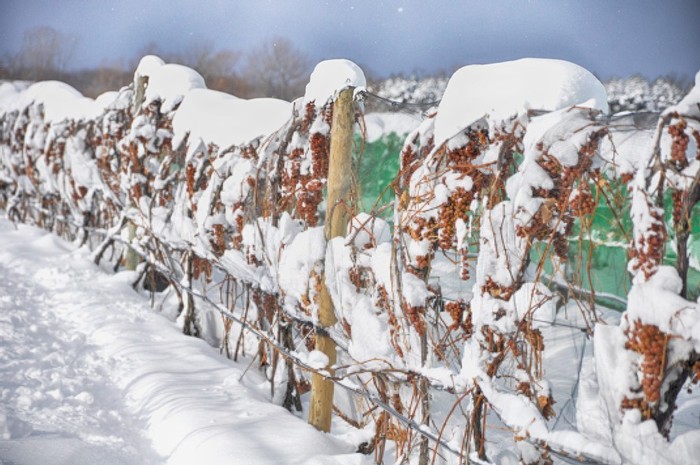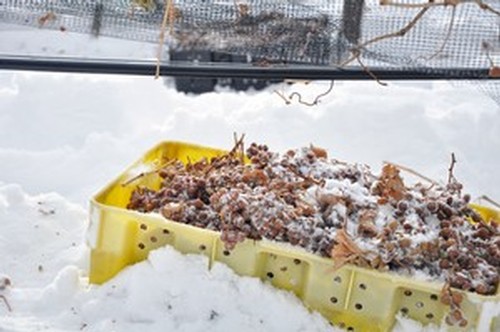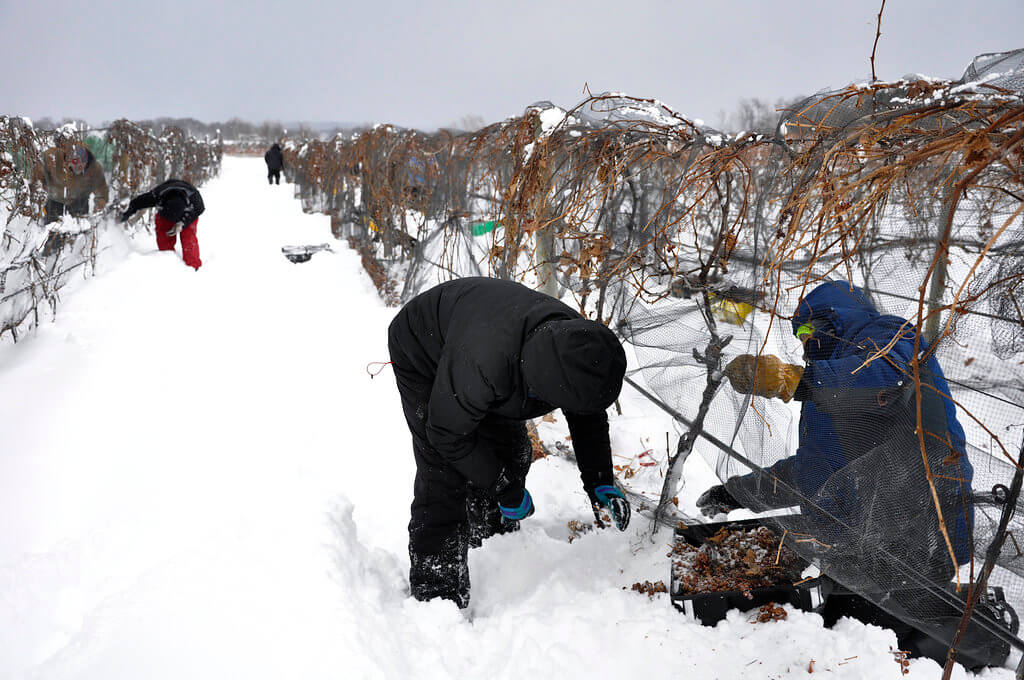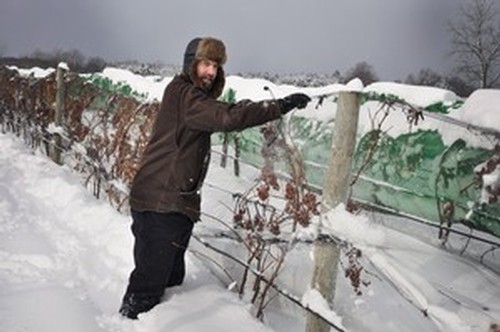Ice Wine, the Second Harvest

In the fall, once the leaves have fallen from the vines, the vineyards allocated for ice wine are covered with netting to protect the fruit from being eaten by birds. This portion of the harvest is delayed until the middle of winter, usually until December or January, and can only proceed if and when the grapes are completely frozen. When temperatures have fallen to roughly twelve degrees Fahrenheit for a day or more, the grapes may be harvested. The harvest of our ice wine grapes is done manually at Johnson Estate, with the fruit being collected in grape bins, stacked on trailers, and taken immediately to the winery for pressing. Ice wine harvests yield approximately 60 gallons per ton of grapes, compared to the September harvest rate of 170 gallons per ton. The difference is the weight of the pure water crystals left behind in the cold pressed grapes.
What is Ice Wine?
It is said that ice wine was first made in Europe during Roman times and rediscovered in Germany after an unexpected frost in the late 1700’s. The production of this very sweet wine became popular in Germany and Austria and is known as “eiswine”. Today, over one million liters of ice wine is made in Canada, where winters are cold enough to reliably produce it every year. A similar climate is also found in Niagara County, NY and certainly, here, in the “snow belt” of western New York.
Grapes which have spent the fall hanging on the vines experience a freeze and thaw cycle that desiccates them and enhances their flavors. When the grapes are solidly frozen, the water in the fruit may be separated from the concentrated sugars – as the sugary liquid freezes at a lower temperature. When the berries are pressed, the frozen water remains in the press with the seeds and skins and an intensely flavored grape juice is extruded. To achieve the highest standards and to produce a non-diluted product, extreme care must be taken to harvest AND to press the grapes while they are still frozen. In western New York, this mean watching the forecasts carefully so as to harvest when the pressing may also be completed at optimally low temperatures.
Johnson Estate has been producing ice wine since 1995. “Ice Wine” is the legal name for wines made from grapes frozen by “Mother Nature”. It can be made only from grapes that have ripened and frozen naturally on the vine – something that our region’s cold winters and blizzards can readily produce. Some wineries do make a “faux” ice wine, which is produced by harvesting grapes and THEN freezing them in freezers prior to being crushed. Regulatory authorities have deemed that they must declare this difference by naming these “faux” ice wines.
What Grapes May Be Used to Make Ice Wine?
Any wine grape may be used for ice wine, although grapes which are later ripening and which tend to stay on the vine are more successful choices. The French-hybrid grape, Vidal Blanc, is a traditional white wine grape used for making ice wine. Riesling, too, is often used. It ripens at the end of the harvest season and also “hangs” well during the winter months. Red wine grapes, of several varieties, typically Cabernet Franc, but also Chambourcin, are also utilized to make ice wine.
Johnson Estate’s Two Ice Wines
What makes a good ice wine? Ice wines are known to be wines with very complex, interesting flavors. The sweetness of good ice wines is balanced by an appropriate level of acidity, creating a delicious dessert wine. Johnson Estate's ice wines are regularly awarded gold medals by Tastings.com and other wine competitions. Here are our latest vintages:
2019 Vidal Ice Wine
Vidal Blanc grapes are an industry standard in the production of ice wine in North America. Each vintage reflects the weather - from the spring until harvest - and the 2019 year resulted in a fine bright, honey-flavored wine with fresh notes of pear. This wine is excellent with nuts, cheeses, cookies, and cakes. Or, even more simply, let it be the star of the show by pairing with crostini with goat cheese and a drizzle of honey, or a slice of peach or apricot. This ice wine was awarded 93 Points at the 2021 International Eastern Wine Competition.
2022 Chambourcin Ice Wine
Chambourcin, a late-ripening red variety of grape makes a rare "red" ice wine. In contrast to the Vidal Blanc Ice Wine, this wine is redolent with fruit notes of plum and currant and even raisin with additional finishing notes of berries. It has a real affinity for any desserts made with chocolate, walnuts, cinnamon, or any combination thereof.
The perfect gift for the wine enthusiast who has already “tried them all”!


